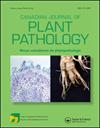墨西哥引起木瓜炭疽病的短孢炭疽菌
IF 1.5
4区 农林科学
Q3 PLANT SCIENCES
引用次数: 0
摘要
摘要2020年9月,在墨西哥瓦哈卡州沿海地区国家皮诺特帕市的一个商业果园中观察到表现出典型炭疽病症状的木瓜品种Maradol。炭疽病发病率达60%。症状包括木瓜果实表面有凹陷的、被水浸湿的分生孢子块。本研究的目的是通过对四个串联数据集的系统发育分析,确定木瓜炭疽病的病因。分离物在马铃薯葡萄糖琼脂上表现出稀疏的白色至灰色气生菌丝体和清晰的同心环,带有橙色分生孢子的渗出物。利用内部转录间隔区(ITS)和部分肌动蛋白(act)、甘油醛-3-磷酸脱氢酶(gapdh)和几丁质合成酶(chs-1)基因的序列数据,该真菌被鉴定为短孢炭疽菌。从患病果实中分离出的真菌在受伤果实和未受伤果实上产生病变。为了满足Koch的假设,从接种的水果上的病变中重新分离出病原体。据我们所知,这是墨西哥首次报道短孢梭菌引起木瓜炭疽病。本文章由计算机程序翻译,如有差异,请以英文原文为准。
Colletotrichum brevisporum causing anthracnose of papaya (Carica papaya L.) in Mexico
Abstract Papaya fruit cv. Maradol showing typical symptoms of anthracnose were observed in a commercial orchard located in the municipality of Pinotepa Nacional at the coastal region of Oaxaca, Mexico in September 2020. The incidence rate of anthracnose reached 60%. The symptoms consisted of sunken, water-soaked lesions with salmon-coloured conidia masses on the surface of papaya fruit. The aim of this study was to identify the causal agent of papaya anthracnose based on the phylogenetic analysis of four concatenated datasets. The isolate exhibited sparse white to greyish aerial mycelium and clearly shaped concentric rings with exudate of orange conidia on potato dextrose agar. The fungus was identified as Colletotrichum brevisporum using sequence data of the internal transcribed spacer (ITS) region, and part of the actin (act), glyceraldehyde-3-phosphate dehydrogenase (gapdh), and chitin synthase (chs-1) genes. The fungus isolated from diseased fruit produced lesions on wounded fruit and unwounded fruit. The pathogen was re-isolated from lesions on inoculated fruit to fulfill Koch’s postulates. To our knowledge, this is the first report of C. brevisporum causing anthracnose disease on papaya fruit in Mexico.
求助全文
通过发布文献求助,成功后即可免费获取论文全文。
去求助
来源期刊
CiteScore
4.50
自引率
5.00%
发文量
56
审稿时长
6-12 weeks
期刊介绍:
Canadian Journal of Plant Pathology is an international journal which publishes the results of scientific research and other information relevant to the discipline of plant pathology as review papers, research articles, notes and disease reports. Papers may be submitted in English or French and are subject to peer review. Research articles and notes include original research that contributes to the science of plant pathology or to the practice of plant pathology, including the diagnosis, estimation, prevention, and control of plant diseases. Notes are generally shorter in length and include more concise research results. Disease reports are brief, previously unpublished accounts of diseases occurring on a new host or geographic region. Review papers include mini-reviews, descriptions of emerging technologies, and full reviews on a topic of interest to readers, including symposium papers. These papers will be highlighted in each issue of the journal and require prior discussion with the Editor-in-Chief prior to submission.

 求助内容:
求助内容: 应助结果提醒方式:
应助结果提醒方式:


